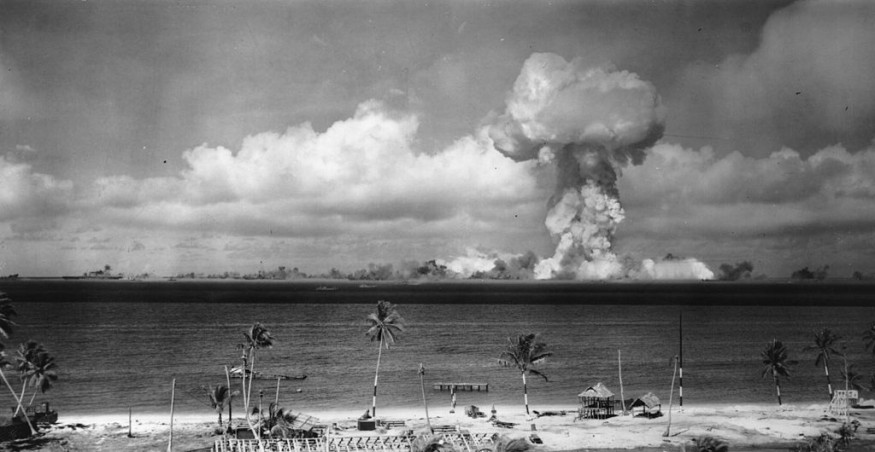The image of a nuclear explosion is almost certainly burned into your mind. An explosion of the magnitude and size of a nuclear detonation is not quickly forgotten, whether as a result of seeing documentaries and movies depicting an explosion or seeing images in pop culture.
The signature enormous mushroom clouds that these explosions produce are perhaps the most noticeable element of them. Most bombs produce clouds that are similar to but not identical to those seen after a nuclear explosion.
So, what causes these clouds to arise in the first place?

In a nutshell, it's because the bomb releases massive amounts of energy all at once. This energy produces a highly hot gas bubble that interacts with the cooler surrounding air, causing it to become less dense. When a nuclear weapon detonates, it emits a blast of x-rays that ionize and heat the surrounding air, forming a fireball.
The swiftly rising hot fireball creates a forceful updraft, eventually filled by the surrounding air and dust. This is what gives rise to the cloud.
However, that was the fast response; to fully comprehend it, we must delve a little deeper.
What is Mushroom Clouds?
To comprehend why nuclear explosions produce mushroom clouds, it is necessary to first describe what these clouds are.
Atomic Archive said mushroom clouds are clouds of smoke and debris that move through the air following an explosion. These clouds arise not only after nuclear explosions but also after any event that generates a lot of heat in a short amount of time. An example would be the detonation of a conventional bomb or perhaps the eruption of a volcano.
Physics of Mushroom Cloud
A big nuclear explosion creates a quick release of heat, which reacts with the surrounding air, making it less dense.
Rayleigh-Taylor instability, per Phys.org, describes the interaction between two materials (fluids or gases) of different densities when they are pressed together.
This principle essentially describes the movement of two fluids with different densities. Because of their various qualities, fluids with different densities are impacted by any given force in different ways. Simply put, when a heavy fluid is supported by a lighter one, RT instability ensues. As the fluids approach equilibrium, the less dense fluid will pass through the more dense fluid.
This "shooting through" of the less dense hot air through the more dense cooler surrounding air occurs at a centralized place in the event of explosions where the less dense hot air is centralized. The mushroom shape is formed by the interactions of these gases.
One thing to keep in mind is that this interaction occurs in any fluid where a less dense fluid supports a heavier one, such as when oil and water mix in a cup. In nuclear blasts, the interaction would continue even if no smoke or debris were present. The smoke and debris are only there to let us see the mushroom cloud creation more clearly.
The initial fireball's less dense hot air will rise and leave a vacuum in its wake. As the flame continues to climb, the colder, denser air is drawn in.
The rising hot air is met with resistance by the colder, denser air, which is a drag on its upward movement. The ascending cloud flattens as a result of this resistance, changing it into a mushroom shape.
The cloud's edges appear to be constantly curling. This is because of the fluid movement caused by the resistance. The air on the fireball's surface is slowly drawn back, only to roll about and be dragged back into the fireball's core.
This cycle repeats until equilibrium is established. The fireball will continue to rise until it reaches the same density as the surrounding air. This is quite high in the atmosphere in nuclear explosions, usually in the ozone layer.
"All atomic bombs produce a bulge and a stem, but the really huge, mushroom clouds are produced by the very high-yield explosions of thermonuclear weapons (hydrogen bombs)," Scientific American said. The same report added that an H-fireball bomb's soars to such heights that it collides with the tropopause, the barrier between the troposphere and the stratosphere. A high-temperature gradient prohibits the two layers of the atmosphere from mixing very well at the tropopause. The fireball's hot bubble expands and rises at first. The bubble is no longer hot enough to break through the boundary by the time it has climbed from sea level to the tropopause. The fireball flattens out at that moment; it can no longer extend vertically, expanding to the side into a mushroom top.
Nuclear Mushroom Clouds Can Reach Tens of Thousands of Feet
Mushroom clouds can reach heights of tens of thousands of feet in minutes, OSTI.gov said. Most passenger flights fly at the height of roughly 33,000 feet or 10,000 meters.
Let's take a look back at what transpired after the nuclear bombing of Hiroshima in 1945. The mushroom cloud ascended to more than 60,000 feet, or nearly 20,000 meters, in less than 10 minutes.
However, this does not provide us with the complete picture. The cloud had risen to the cruise altitude of the Enola Gay, the plane that dropped the bomb, in less than 30 seconds, despite being more than 20,000 meters high in the first 10 minutes. The cloud had climbed 10,000 meters in 30 seconds, according to this calculation. When averaged out, this indicates the cloud rose at 333 m/s for the first 10 minutes, then slowed to just 100 m/s after that.
Finally, mushroom clouds aren't caused by nuclear explosions; rather, they're caused by Rayleigh-Taylor Instabilities in fluids, a principle we observe every day.
RELATED ARTICLE : Nuclear Fusion: World's First-Ever Reactor To Be Tested This Summer
Check out more news and information on Energy and Physics in Science Times.
© 2026 ScienceTimes.com All rights reserved. Do not reproduce without permission. The window to the world of Science Times.












